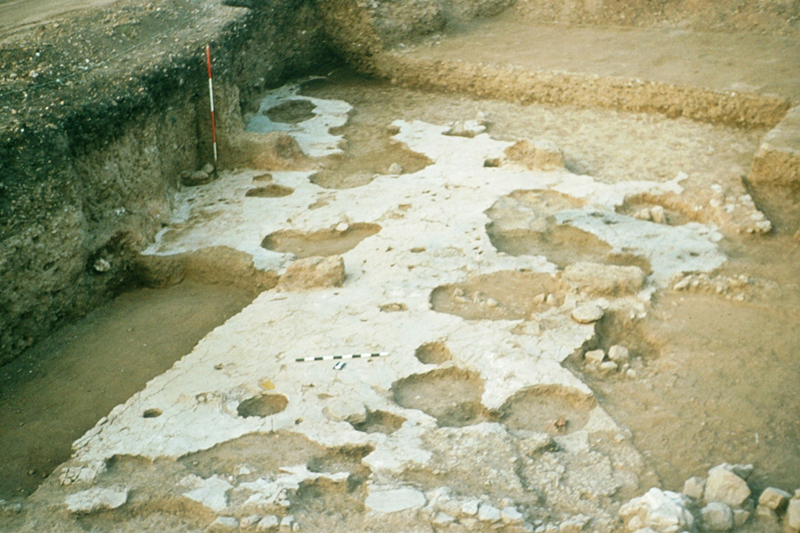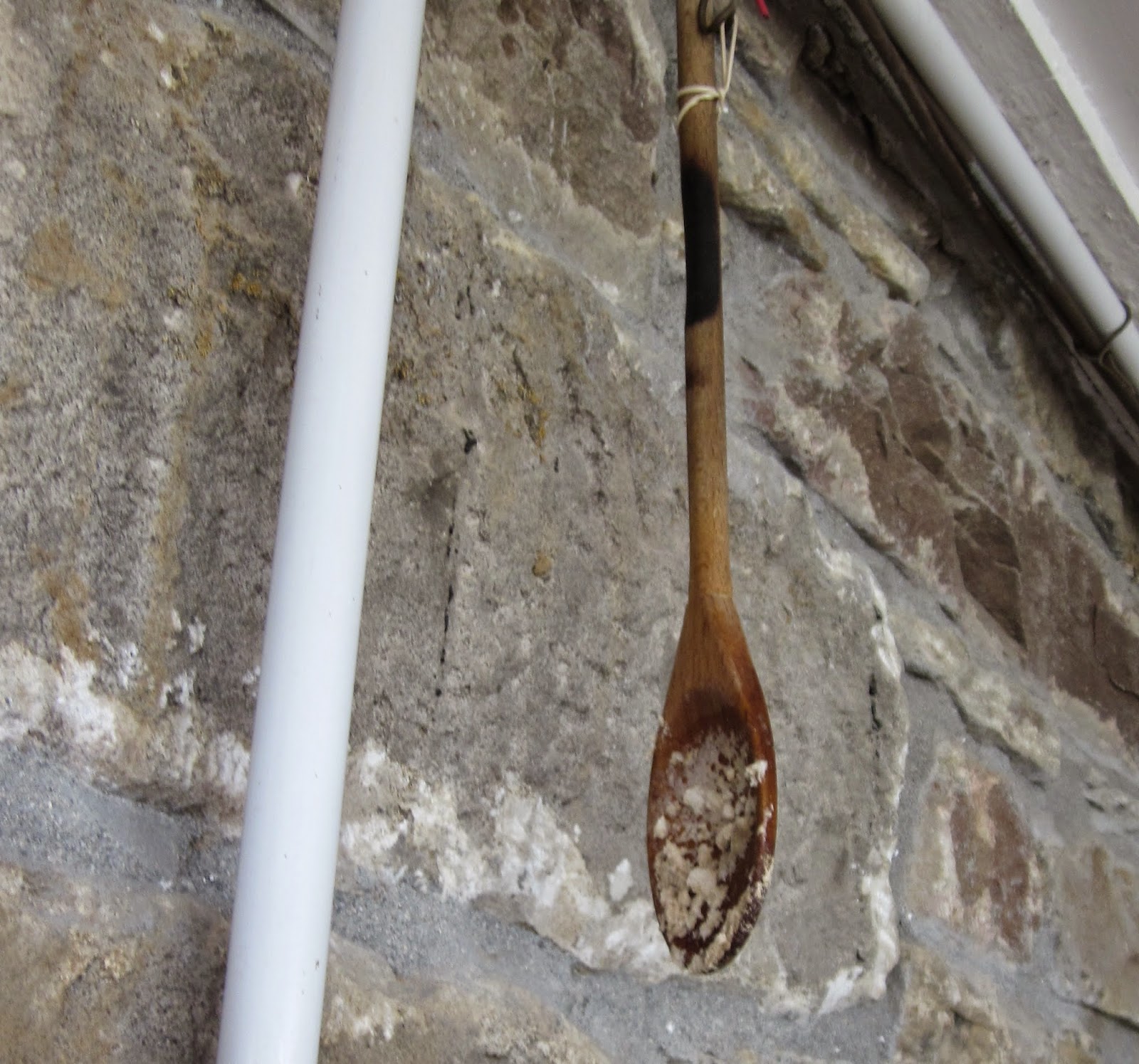Sometimes, a single sentence in an excavation report can be the beginning of research that sparks your curiosity and makes you ask questions. For me, it was a few words and a brief, enigmatic description that I read in an excavation report several years ago, in the late 1990s, when I began my research into ancient grain processing techniques and the neolithic revolution.
The site was Beidha, a small neolithic village in the Jordan Valley. Here, in the 7th Millennium BC, people began to settle down, grow grain and keep domestic animals - cows, pigs, sheep and goats. Although they were still hunting and gathering, they were beginning to process the crops they grew, which included cereals and lentils. The earliest agriculturalists. Today, when you search for the neolithic village of Beidha on the internet you will find lots of information about it. This is, to some extent, thanks to a
project established in 2010, to protect and promote the site.
Beidha is an
ancient place, now open to the public. It is not far from Petra, in
Jordan, and is part of the World Heritage Site. Definitely on my list of places to go.
The village appeared to have burned down, nobody knows how or why. Diana Kirkbride excavated the site in the 1950s and 1960s as part of a larger project to investigate the early agriculturalists of the Ancient Near East, organised by
Robert Braidwood of the Oriental Institute of Chicago. In her report, she
described the remains and the contents of one of the rectangular mud brick buildings in the village of Beidha. As well as a lime plaster floor, facilities and
equipment suitable for grain agriculture and processing were found,
specifically, hoes, sickles and quern stones. There were also large stone bowls and the
remains of baskets that appear to have been waterproofed. The baskets had been lined with either bitumen or
lime plaster.
She thought that the building may have burnt down, somehow leaving behind the evidence of the presence of grain on
the floor, which she described as
“
...
tens of thousands of grain impressions in the burnt plaster floor ...”
Kirkbride, D. 1968 ‘Beidha: early neolithic village life south of the
Dead Sea’ Antiquity XLII, 263
This is an intriguing description.
At the time that I was studying the Beidha excavation report, Graham and I had recently returned from Orkney where, at the Corrigall Farm Museum, we had
our first lesson in the techniques and traditions of floor malting. The curator, Mr Harry Flett, had explained to us how the grain must be steeped in water, then turned out onto a smooth floor in a barn to begin germination. Malt is partially germinated grain. When growth is obvious, that is, when the root and shoot begin to show, the malt is carefully dried. Then it can be used for making
wort and brewing ale.
I had been reading excavation reports from neolithic sites in the British Isles and northern Europe, where floor surfaces of buildings are rarely preserved. The floors of the long houses and other buildings of the
Linearbandkeramik Culture were destroyed by modern deep ploughing. In the British Isles, I had only come across one description of a deliberately made beaten earth floor in a neolithic building. This was in one of the rectangular timber buildings at
Lough Gur, in Ireland, a site excavated in the early 1950s by Sean O'Riordain and published in the
Proceedings of the Royal Irish Academy.
It was great news to me that some floor surfaces of buildings from early
neolithic cultures in the ancient Near East had been so well preserved. I began to read more excavation reports, to see what else had been
discovered. Although I have yet to find another description of grain
impressions in association with an early neolithic lime plaster floor from that part of the world, I did find plenty of detailed descriptions of floors made of beaten earth, stamped clay and lime plaster. Some of them were painted, and there was very little discussion of their function or purpose.
The function of floors is
a subject not often discussed in excavation reports. Floors are important. They are a crucial facility for making malt. And, as many people know, it's
the malting that interests me most. When was it discovered? How? Who
were the first maltsters? How has malting technology changed and
developed over the millennia? What is the archaeological evidence
for malt? What role did malting play in the development of grain agriculture and the neolithic revolution?
the neolithic revolution in the Fertile Crescent
The practice of grain cultivation, agriculture and grain processing as well as animal husbandry and the domestication of cattle, sheep, goats and pigs are defining
features of the neolithic way of life.
Archaeologists agree on this definition, although there is much disagreement among the academics about why people "became farmers". It is one of the biggest questions in academic archaeology - why did people begin to
cultivate and process wild grains in the Ancient Near East and
Levant? What were they making with the
grain? These were some of the questions that Braidwood's team of archaeologists, anthropologists and archaeobotanists and had set out to answer in the 1950s. Was it bread or beer?
The debate was reawakened in the 1980s by
Solomon Katz and Mary Voigt, when they published their paper "Bread or Beer: the early use of cereals in the human diet". They suggested that making malt was an important part of the story. Hunting and gathering were, of course, still important ways of food acquisition. Wheat and barley grew as wild plants in this region. People began to gather and process them long before they started to cultivate them deliberately and settle down in villages to tend their crops and look after their sheep, goats, pigs and cattle.
Grain cultivation and
processing began in the Near East and Levant around ten to twelve thousand years ago. This new way of life spread across Europe and reached the British Isles around six thousand years ago.
mud, clay & lime plaster floors in the neolithic of the Fertile Crescent
A common feature of many early neolithic sites in the Fertile Crescent are the deliberately made, smooth, level floors made of mud, clay or lime plaster. Mud or clay floors may have been relatively easy to make. The lime
plaster floors, some of them apparently polished, would have involved a
particularly complex technology in their manufacture, as well as
considerable human effort and co-operation in their construction. The Natufians, these first agriculturalists of the Fertile Crescent, were using lime plaster for a wide range of uses - to make walls, floors, statues, as well as so called 'white ware' vessels, the precursor to pottery made from clay. The use of lime plaster in the early neolithic of the Fertile Crescent is a huge area for research and investigation.
To make lime plaster, large
quantities of chalk had to be collected, then burnt at 850 degrees
Centigrade to make the quicklime. Water would have been added to
make the slaked lime which can then be used to make the floor. They must be laid and levelled very quickly and would have been similar in appearance to a modern concrete floor.
Polished lime plaster floors were found in a rectangular building at
Gobekli Tepe, in the layers of this enigmatic settlement or temple dated to the seventh and eighth millennia BC, the era of the
pre pottery neolithic. Gobekli Tepe was excavated by Professor Klaus Schmidt of the German Archaeological Institute over many seasons. The earliest levels have been dated to the epi-palaeolithic, around the tenth millennium BC. The team excavating this site interpreted it as having been a place of feasting and cult activity.
Another interesting and large rectangular building of the seventh
millennium BC was excavated at the early neolithic village of Yiftahel, lower Galilee. Inside one of the buildings there was a lime
plaster floor measuring 110 square metres and 3-6 cm thick. It would
have required some seven tons of lime plaster. At the time of
excavation, it was the largest rectangular mud brick building of the
period in the Levant. Details of the lime plaster, what it was and how it was made can be found
here in a paper published in the Journal
Palaeorient in 1991.
 |
| remains of a lime plaster floor at Yiftahel: the production of lime plaster was on an industrial scale. see here |
 |
| bins, pestles, mortars & earth floors at Ain Mallaha see here |
At
Ain Mallaha there are the remains of an early
neolithic settlement. It is situated by Lake Huleh in the upper Jordan
valley and was inhabited between 10,000 and 8200 BC. The floors within
the buildings apparently gave the impression of having been deliberately
made by accumulation and they appear to have been cleaned and repaired
on a regular basis.
Stamped mud floors, some
surfaced with a
smooth layer of clean clay, together with domed ovens and brick-lined roasting pits were features discovered during excavations at
Ali Kosh,
a neolithic settlement dated to c7200 BC and located on the southern
plains of Khuzistan.
At
Tell Ramad, a neolithic
village in Syria, c7000–6000 BC, the remains of lime kilns were excavated and some of the
floors were made of lime plaster. Again, lime plaster was being made on an almost industrial scale. During excavations, it was noted that some of the
floors had upturned edges. What purpose was this innovation for? We may never know, but perhaps
this refinement had the function of containing the malt. It would work to keep the germinating grain
on the specially made lime plaster floor surface.
Floors of
compacted clay were found in the buildings of the earliest and
lowest occupation levels at
Mureybit a settlement dated to between
c8500 and c6900 BC and located beside the Euphrates river in northern
Syria. Excavations also revealed a variety of grain
agriculture and processing equipment including sickles, pestles, mortars,
quern stones, fire pits and hearths.
A floor at the site of
Ain Ghazal, an early neolithic
settlement near Amman in Jordan, showed evidence of at least five
different layers. It had been repeatedly repaired and well maintained. Re plastering
and regular maintenance of these lime plaster floors was undertaken at a number of these early neolithic sites.
This is a feature of more recent malting floors. It is desirable to
have a smooth and level surface for the efficient raking and turning of
the grain as it germinates. Access to a reliable water source
is another necessity for the malting and mashing of grain and at all of these sites that I have mentioned, there were nearby springs, streams or rivers.
Robert Braidwood of the Oriental Institute of Chicago initiated the "Bread or Beer" debate in 1953. Anthropologists and archaeologists discussed the roles of bread and beer in the Origin of Grain Agriculture debate. Only Hans Helbaek considered the role of malt, without which there would be no fermentable sugars and no beer.
The archaeological evidence, some of which is outlined above, indicates that it was neither bread nor beer, rather it seems that those first agriculturalists may have been making malt.
-------------------------------------------------------------
further reading:
I have a peer reviewed paper "The Craft of the Maltster" which is hopefully, due to be published soon. It was presented to the Food in Archaeology Conference in April 2010 at Exeter University. The book of the conference is, I am assured, on its' way into print. I have been given permission by the publishers to put the paper on my academia page. It can be downloaded
here.

















